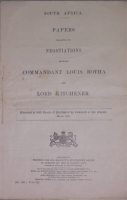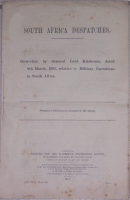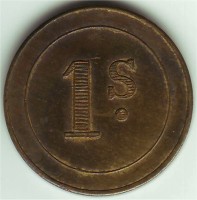 Stephanus Johannes Paulus Kruger was born on 10 October
1825 at Bulhoek, his grandfather's farm in the Steynsburg district . He grew
up on the farm Vaalbank. His school was the veld and he had only three months'
formal education, his master being one Tielman Roos. His father, Casper Kruger,
joined the trek party of Hendrik Potgieter when the Great Trek started in
1836.
Stephanus Johannes Paulus Kruger was born on 10 October
1825 at Bulhoek, his grandfather's farm in the Steynsburg district . He grew
up on the farm Vaalbank. His school was the veld and he had only three months'
formal education, his master being one Tielman Roos. His father, Casper Kruger,
joined the trek party of Hendrik Potgieter when the Great Trek started in
1836.
Settling in the Transvaal
The trekkers crossed the Vaal River in 1838 and at first stayed in the area
that is known today as Potchefstroom. Kruger's father later decided to settle
in the district now known as Rustenburg. At the age of 16, Paul Kruger was
entitled to choose a farm for himself at the foot of the Magaliesberg where
he settled in 1841.
The following year he married Maria du Plessis and the young couple accompanied
Casper Kruger to live in the Eastern Transvaal for a while. After the family
had returned to Rustenburg, Kruger's wife and infant son died, probably from
malaria. He then married Gezina du Plessis, who was his constant and devoted
companion until her death in 1901. Seven daughters and nine sons were born
of the marriage, some dying in infancy.
Image below: A hallmarked silver medallion commemorating
the removal of the Kruger statue to Church Square, Pretoria on 11 October
1954. This was 50 years after the death of Paul Kruger (see
below).


Kruger, the leader
Kruger started as a fieldcornet in the commandos and eventually became
Commandant-General of the South African Republic (Transvaal). He was appointed
member of a commission of the Volksraad (Republican Parliament) that was
to draw up a constitution. People began to take notice of the young man and
he played a prominent part in ending the quarrel between the Transvaal leader,
Stephanus Schoeman, and M W Pretorius. The latter afterwards became the first
President of the South African Republic and was the founder of Pretoria.
He named it after his father, Andries Pretorius.
Vice-President 1874
In 1873 Kruger resigned as Commandant-General, and for a time he held no
office and retired to his farm, Boekenhoutfontein. In 1874, however, he was
elected to the Executive Council and shortly after that became Vice-President
of the Transvaal.
After the annexation of the Transvaal by Britain in 1877, Kruger became the
leader of the resistance movement. During the same year, he visited England
for the first time as leader of a deputation. In 1878 he was part of a second
deputation. A highlight of his visit to Europe was when he ascended in a
balloon and saw Paris from the air.
Image right: Oom Paul Kruger and his wife Gezina
- this original family photo in the Balson Holdings Family Trust has
been stored to ensure that the fingerprints on it, believed to be those of
Paul Kruger, have not been damaged - click photo to see the fingerprints.
This claim comes down the line of a family who were close to the Boer
President.
First War of Independence against the British
The first War of Independence started in 1880 and the British forces were
defeated in the decisive battle at Majuba in 1881. Once again, Paul Kruger
played an important role in the negotiations with the British, which led
to the restoration of the Transvaal's independence under British sovereignty.
First Presidency 1882
At the age of 57, Kruger was elected President of the Transvaal. One of his
first aims was the revision of the Pretoria Convention of 1881. Therefore,
he again left for England in 1883, empowered to negotiate with Lord Derby.
Kruger and his companions also visited the Continent and this visit became
a triumph in countries such as Germany, Belgium, the Netherlands, France
and Spain. In Germany, he attended an imperial banquet at which he was presented
to the Emperor, Wilhelm I, and spoke at length with the renowned Bismarck.
Image below: A scarce Boer commemorative folding
or pocket knife (white metal) with corkscrew in the Balson Holdings Family
Trust collection. This particular knife depicts the images of President Paul
Kruger of the ZAR as well as General Christiaan de Wet, the war hero of the
boers.
 |
 |
| "Eendracht Maakt Macht" and crest |
Paul Kruger and de Wet |
Discovery of Gold the Republic's undoing
In the Transvaal, things changed rapidly after the discovery of gold on the
Witwatersrand. This momentous discovery was to have far-reaching political
repercussions and to give rise to the uitlander (foreigner) problem, which
was eventually lead to the fall of the Republic.
At the end of 1895, the so called Jameson raid took place - the attack being
launched from Mafeking - one of the first towns to
be put under siege when the boer war broke out in 1899. The force
was largely made up of the little known Bechuanaland
Border Police which numbered about 500 men. Once more Kruger's calm
and determination was put to the test. Jameson was forced to surrender, taken
to Pretoria and handed over to his British countrymen for punishment. Cecil
Rhodes' British South African Company was clearly behind the attack although
Rhodes escaped conviction. The raid did draw attention to the manner in which
the "Outlanders" (mainly British citizens running the gold mines on the
Witwatersrand) were treated. The Outlanders had no voting rights, were haevily
taxed and were treated with scorn by the Volksraad.
Fourth Presidency
In 1898, Kruger was elected President for the fourth and last time.
Original Land Title Deeds signed by Paul Kruger in
1898
Just a few months before the start of the 1899-1902 boer war Paul Kruger
was dishing out land titles to burghers in Pretoria.
The documents below are original land titles signed by Paul Kruger and bearing
the seal of the Zuid Afrikaansche Republiek. The property was situated in
what is now the CBD of Pretoria. As you will see in the summary of Paul Kruger's
life, at this link, the Boer leader only had three
months of formal education - thus his baby-like signature.
They form part of the Balson Holdings Family Trust collection

(300k download) |

Kruger's signature |
 |
|
The Anglo-Boer war On 11 October 1899, the Anglo-Boer War broke out. On 7
May 1900, Kruger attended the last session of the Volksraad and on 29 May,
he left Pretoria as Lord Roberts advanced on the boer's capital. For weeks
he either stayed in a house at Waterval-Onder or in his railway carriage
at Machadodorp near Pilgrim's Rest in the Eastern Transvaal.
Image right: The boers were marksmen and loved ambushing
the British from rocky positions.
A British Empire jacket used by the army during the boer war
can be seen at this link. This garment is
in the Balson Holdings Family Trust collection.
Days before the boers were defeated in Pretoria they
issued bank notes to pay debts, after
some deliberation these bank notes were honoured by the new British colonial
government after the defeat of the boers in 1902.
| Extract "With the Guards'
Brigade" (Rev E P Lowry) - 1902:
pg 224.. The valiant old President so long ago as September 11th had fled
with his splendidly well-flled money bags across the Portuguese frontier
(near Waterval Boven), abandoning his burghers wh were still in the fiel;d
to whatever might chance to be their fate. |
Eventually, it was decided that he should go to Europe on behalf of the Republic,
while the war continued (see image below). He left from Lourenco Marques
in October 1900. Queen Wilhelmina of the Netherlands sent the battleship
De Gelderland to fetch him and his entourage. His wife was much too sick
to accompany him and Gezina Kruger died on 20 July 1901.
They landed in Marseilles, where an overwhelming ovation awaited the President.
He travelled through Europe to Holland where he stayed for the duration of
the war, his last home being Oranjelust in Utrecht. Here he received the
news that the treaty (the Peace of Vereeniging) had been signed. The Boer
generals - Botha, De Wet and De la Rey - also paid him a visit when they
were in Europe in 1902 after the war.
Proclamation measuring approx 17 by 20 inches
 |
The original proclamation posted by Field
Marshall Roberts on the 14th September 1900 held by the Balson Holdings
Family Trust
This unique document was posted in Johannesburg following the departure of
President Paul Kruger for Lourenco Marques and states
that Kruger had "deserted" the boers and that they should surrender to the
British... they did not!
Shortly after this in March 1901 the Bitish started
routing the boers - see despatches and papers below.
(Certificate of Authenticity held)
 Two weeks after Kruger left South Africa Lord Roberts thought
he had the boers beat and started talking about the early return of the troops.
Two weeks after Kruger left South Africa Lord Roberts thought
he had the boers beat and started talking about the early return of the troops.
Clicking on the image on the right will take you to a scarce
original copy of a letter from Roberts to the people back home in which he
talks of his troops great character and pleads with those at home not to
provide his men wih liquor as this action would
"lead them into excesses which must tend to degrade
those whom the nation delights to honour". Of course Roberts'
optomistic view was shattered as the boers continued to fight for over two
years.
The boers fought on in the Transvaal despite Paul Kruger's apparent "desertion"
and issued bank notes at Pietersburg in 1901
and Te Veld bank notes in 1902 - together
with the rare Veld Pond.
Kruger's death 1904
The President moved to Clarens in Switzerland where he stayed for the last
six months of his life. He died on 14 July 1904 and his remains were temporarily
interred at the Hague and were brought to Cape Town from Rotterdam in the
Dutch ship De Batavier VI. His body was then taken to Pretoria by train and
he was buried on 16 December 1904 in the Church Street cemetery.
Despatches and negotiations between the boers and "General Kitchener
of Khartoum":
(Documents held by the Balson Holdings Family Trust)
Papers relating to terms of surrender between Commandant
Louis Botha (boers) and Lord Kitchener (British)
 Ten page report presented to both Houses of Parliament
by Command of His Majesty - March 1901
Ten page report presented to both Houses of Parliament
by Command of His Majesty - March 1901
The transcript of eleven key telegrams between Lord Kitchener and the High
Commissioner, Sir Alfred Milner.
A telegram from Kitchener goes into great detail about his meeting with Botha
on the 28th February 1901 in summary the following was discussed:
-
A request for representative not military Government in the Transvaal
-
That the boers be allowed to retain firearms
-
The Dutch language to be maintained
-
The "Kaffir" question - Orange Free State laws relating to "kaffirs" to be
introduced.
-
Dutch Church property to remain untouched
-
Public trusts and orphan funds to be left untouched. British Government to
take over legal debts (such as the ZAR bank notes). Botha refers to bank
notes issued amounting to less than on million pounds.
-
That no war tax be imposed on farmers
-
The return of prisoners of war to not be delayed
-
Pecuniary assistance to help farmers start again
-
Amnesty to all at the end of the war.
When the above were agreed to, Botha responded on 16th March 1901 that "I
do not feel disposed to recommend that the terms of the said letter shall
have the earnest consideration of my Government. I may add also that my
Government and my chief officers here entirely agree to my views".
And so the boer war continued....
South African Despatches - 8th March
2001
Sixteen page report presented to Parliament by Command of His Majesty
The document right sets out the state of the war with the boers - with Kitchener
gleefully reporting on the routing of the boer forces in all areas except
for the northern part of Transvaal - around Pietersburg and to the east around
Pilgrims Rest - where the veld pond was defiantly
struck in 1902.
See also the bank notes printed in Pietersburg
(1901) and Te Veld notes in Pilgrims Rest (1902).
The main action between General French (British) and Commandant General
Botha (boers) is summarised in the despatch by the capture thus:
296 Boers killed and wounded
177 Prisoners of war
555 surrendered prisoners
784 rifles
199,300 rounds rifle ammunition
6,289 horses
26,927 cattle
175,514 sheep and
1,747 wagons and carts
Days later Commandant Botha rejected Kitchener's surrender terms and the
boers moved north to Pietersburg.

 Stephanus Johannes Paulus Kruger was born on 10 October
1825 at Bulhoek, his grandfather's farm in the Steynsburg district . He grew
up on the farm Vaalbank. His school was the veld and he had only three months'
formal education, his master being one Tielman Roos. His father, Casper Kruger,
joined the trek party of Hendrik Potgieter when the Great Trek started in
1836.
Stephanus Johannes Paulus Kruger was born on 10 October
1825 at Bulhoek, his grandfather's farm in the Steynsburg district . He grew
up on the farm Vaalbank. His school was the veld and he had only three months'
formal education, his master being one Tielman Roos. His father, Casper Kruger,
joined the trek party of Hendrik Potgieter when the Great Trek started in
1836.


 Resistance movement 1877
Resistance movement 1877


 The Jameson raid
The Jameson raid



 Anglo-Boer War
Anglo-Boer War




